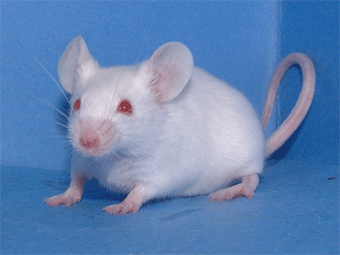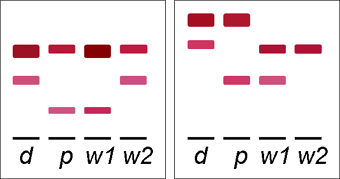BALB/c Hbb Congenic StrainsSustaining Hemoglobin Beta Chain VariationsBALB/c-Hbbp RBRC 00578BALB/c-Hbbw1 RBRC 00568BALB/c-Hbbw2 RBRC 01451BALB/cAn(Hbbd) RBRC 00641Hbb:Hemoglobin beta chain complex (Chr7) |
|
 RBRC No.00641 BALB/cAn (Hbbd) |
 Schematic figures of protein electrophoresis patterns using acetate cellulose plates. Four Hbb haplotypes can be distinguished by iodoacetic acid treatment (Right). Left:Blood samples were treated by distilled water. Right:Blood samples were treated by iodoacetic acid. |
Several haplotypes of the hemoglobin beta chain (Hbb) have so far been identified; d ands in the common inbred strains, and p, w1 and w2 in the Asian wild-derived strains [1-4]. The unique Hbb haplotypes derived from wild mice have been introduced into the BALB/c genetic background. Haplotype-p was introduced from the Japanese wild-derived strain MSM/Ms (Mus musculus molossinus), w1 from the mouse captured at Jiayuguang, Gansu Province in China, and w2 from the mouse captured around Lake Balkhash in the Republic of Kazakhstan. These haplotypes can be distinguished by cellulose-acetate membrane electrophoresis. An analysis of nucleotide sequences of Hbb-b1, -b2 and the neighboring genome revealed that the p haplotype is a recombination between d and w1 haplotype [4,5,6]. These congenic strains are invaluable resources to resolve the evolutionary and phylogeographic history of the wild and domesticated populations of M. musculus, as well as the biological functions of hemoglobin.





